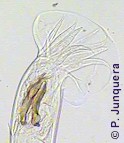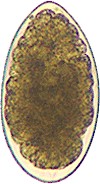Trichostrongylus, also called hairworms, is a genus or parasitic roundworms belonging to the family called Strongylidae that affects cattle, sheep, goats and other ruminants, as well as pigs, horses and poultry. It also infects wildlife (deer, antelopes, camels, monkeys, wild boars, zebras, etc.).
belonging to the family called Strongylidae that affects cattle, sheep, goats and other ruminants, as well as pigs, horses and poultry. It also infects wildlife (deer, antelopes, camels, monkeys, wild boars, zebras, etc.).
It is found worldwide. In ruminants, Trichostrongylus worms are mostly found in mixed infections with other gastrointestinal roundworms (e.g. of the genera Cooperia, Haemonchus, Ostertagia, etc.).
There are about 30 species worldwide. The most relevant for livestock are:
- Trichostrongylus tenuis. Infects poultry and other birds worldwide
- Trichostrongylus axei. The stomach hairworm. Infects cattle, sheep, goats, pigs and horses and many wild mammals. Found worldwide
- Trichostrongylus colubriformis. Bankrupt worms, black scours worms. Infects cattle, sheep, goats, pigs and horses and many wild mammals. Found worldwide
Other less frequent species are Trichostrongylus probolurus and Trichostrongylus vitrinus.
Neither dogs nor cats are affected by this species.
Some Trichostrongylus worms can incidentally infect humans if they ingest water or vegetables contaminated with infective larvae, which happens more frequently in rural regions with poor sanitary conditions. Human infections with Trichostrongylus have been reported mainly in Asia and Africa. Most infections are rather benign.
The disease caused by Trichostrongylus worms is called trichostrongylosis or trichostrongyliasis.
Are animals infected with Trichostrongylus worms contagious for humans?
- NO. Direct contact with infected livestock, horses, birds or their fresh feces is not contagious for humans because the eggs shed with the feces have to mature in the environment to become infective. For more details about the life cycle of these worms see below.
You can find additional information in this site on the general biology of parasitic worms and/or roundworms.
Final location of Trichostrongylus worms
- Predilection site of adult Trichostrongylus worms is the small intestine.
- Predilection site of Trichostrongylus axei is the stomach, occasionally the small intestine.
- Predilection site of Trichostrongylus tenuis in poultry is the cecum.
Anatomy of Trichostrongylus worms

Adult Trichostrongylus worms have a slender form and a brownish-reddish color and are 5 to 10 mm long, depending on the species.
As other roundworms the body of these worms is covered with a cuticle, which is flexible but rather tough. The worms have no external signs of segmentation. They have a tubular digestive system with two openings. They also have a nervous system but no excretory organs and no circulatory system, i.e. neither a heart nor blood vessels.
Males have two spicules for attaching to the female during copulation. The spicules of Trichostrongylus colubriformis have the same length, whereas those of T. axei and T. tenuis are different.
The eggs are ovoid, have a thin shell, measure ~40x80 micrometers, and are embryonated when shed.
Life cycle Trichostrongylus worms
All Trichostrongylus species have a direct life cycle, i.e. there are no intermediate hosts involved. Adult females lay eggs in the large intestine of the host that are shed with the feces. Once in the environment the eggs release the L1-larvae that complete development to infective L3-larvae in about 5 days by suitable weather (hot and humid), significantly longer by cold weather. These infective larvae can survive in the environment and remain infective for up to 6 months.
Livestock becomes infected after ingesting such larvae while grazing or with contaminated soil. After ingestion, larvae of Trichostrongylus axei complete development to adult worms in the stomach, where they may penetrate into the lining of the abomasum. Larvae of other species reach the small intestine, where they get into the crypts of the lining and complete development to adults.
The prepatent period (time between infection and first eggs shed) is 3 to 4 weeks, depending of the species and the host.
Harm caused by Trichostrongylus worms symptoms and diagnosis

As other gastrointestinal roundworms, Trichostrongylus worms damage the lining of the small intestine or the stomach (T. axei) of the host, which can lead to enteritis, gastritis, and sometimes anemia as well. Typical signs are diarrhea (mucous and/or hemorrhagic) or constipation, general weakness and wasting, loss of appetite, reduced weight gains or even weight loss, etc.
Acute severe infections in young animals may be fatal. Since most infections are mixed with other gastrointestinal roundworms (e.g. Cooperia spp, Haemonchus spp, Ostertagia spp, etc.) it is not easy to ascribe the damage to Trichostrongylus or to other worms.
Trichostrongylus tenuis is also seriously harmful for poultry, particularly for young geese. It is usually not a problem in modern industrial poultry production, but can be a serious threat under traditional outdoor farming conditions.
Diagnosis is confirmed after detection of characteristic eggs in the feces. However, determination of the species requires post mortem examination of adult worms after necropsy.
Prevention and control of Trichostrongylus infections
In cattle, sheep and goats Trichostrongylus worms occur mainly in mixed infections with other gastrointestinal roundworms (in ruminants Haemonchus, Ostertagia, Cooperia, etc; in horses Cyathostomins and Strongylus spp) and increase the damage. Consequently, whatever reduces pasture contamination with infective larvae (e.g. adequate pasture rotation) or exposure of livestock to such larvae will diminish the impact on the herd. Such preventative measures are the same for all gastrointestinal roundworms and are explained in a specific article in this site (click here). Infection of livestock indoors is infrequent but possible.
In the case of Trichostrongylus axei it must be considered that infective larvae are rather resistant to cold and dryness and can survive on pasture for up to 6 months.
Livestock exposed to these worms often develop natural resistance progressively and may recover spontaneously. Such resistant animals do not become sick if re-infected, but continue shedding eggs that contaminate their environment.
Numerous broad spectrum anthelmintics are effective against adult worms and larvae, e.g. several benzimidazoles (albendazole, febantel, fenbendazole, flubendazole, mebendazole, oxfendazole, etc.), levamisole, as well as several macrocyclic lactones (e.g. abamectin, doramectin, eprinomectin, ivermectin, moxidectin). A few other narrow-spectrum anthelmintics such as tetrahydropyrimidines (e.g. morantel, pyrantel) are effective against adult worms but may not control larvae and other roundworm species that often infect livestock simultaneously with Trichostrongylus worms.
In numerous countries monepantel, an anthelmintic of a new chemical class, is also available as a drench for use on sheep and goats. It is effective against Trichostrongylus axei, Trichostrongylus colubriformis, Trichostrongylus rugatus, and Trichostrongylus vitrinusadults and immature L4 larvae, even those resistant to other anthelmintics., but only against inhibited larvae of Trichostrongylus axei. It is not approved for cattle.
Depending on the country, most of these anthelmintics for livestock are available for oral administration as drenches, feed additives and/or tablets. Levamisole and most macrocyclic lactones are usually also available as injectables. A few active ingredients are also available for livestock as pour-ons and slow-release boluses. Most anthelmintics for use on horses are available as oral pastes or gels.
Numerous commercial products contain mixtures of two or even more active ingredients of different chemical classes. This is done to increase the chance that at least one active ingredient is effective against Trichostrongylus and other gastrointestinal worms that have become resistant, or to delay resistance development by those worms that are still susceptible.
Excepting slow-release boluses, most wormers containing benzimidazoles (e.g. albendazole, febantel, fenbendazole, flubendazole, mebendazole, oxfendazole, etc.), levamisole, tetrahydropyrimidines (e.g. morantel, pyrantel) and other classic anthelmintics kill the worms shortly after treatment and are quickly metabolized and/or excreted within a few hours or days. This means that they have a short residual effect, or no residual effect at all. As a consequence treated animals are cured from worms but do not remain protected against new infections. To ensure that they remain worm-free the animals have to be dewormed periodically, depending on the local epidemiological, ecological and climatic conditions. An exception to this are macrocyclic lactones (e.g. abamectin, doramectin, eprinomectin, ivermectin, moxidectin), that offer several weeks protection against re-infestation, depending on the delivery form and the specific parasite.
There are so far no true vaccines against Trichostrongylus worms. To learn more about vaccines against parasites of livestock and pets click here.
Biological control of Trichostrongylus (i.e. using its natural enemies) is so far not feasible. Learn more about biological control of worms.
You may be interested in an article in this site on medicinal plants against external and internal parasites.
Resistance of Trichostrongylus worms to anthelmintics
There are numerous reports on confirmed resistance of several Trichostrongylus species to most used anthelmintics (benzimidazoles, ivermectin, levamisole, etc) in sheep, goats and cattle. So far not on horses or poultry.
This means that if an anthelmintic fails to achieve the expected efficacy against Trichostrongylus worms, there is a significant risk that it is due to resistance to anthelmintics, particularly in sheep, goats and cattle.
Learn more about parasite resistance and how it develops.
|
Ask your veterinary doctor! If available, follow more specific national or regional recommendations for Trichostrongylus control. |